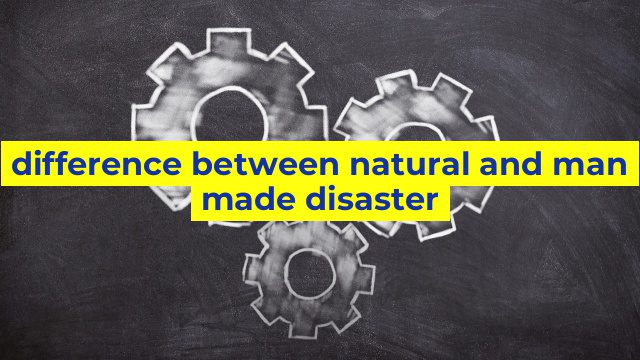Difference Between Natural Disasters and Man-Made Disasters
Natural disasters and man-made disasters are two different terms used in the study of disaster management. While natural disasters are caused by natural forces, man-made disasters are caused by human actions or inactions. Understanding the difference between natural disasters and man-made disasters is crucial in mitigating their potential impact and losses.
What Are Natural Disasters?
Natural disasters are natural events that occur in the environment, leading to economic, social, and environmental losses. These disasters include but are not limited to earthquakes, hurricanes, floods, tsunamis, landslides, and wildfires. Natural disasters often occur without any warning and can be life-threatening.
What are Man-Made Disasters?
Man-made disasters, also known as human-made disasters, occur due to human negligence, errors, or deliberate intent. These disasters can be caused by human activities such as transportation accidents, oil spills, nuclear accidents, and explosions. Man-made disasters can also occur due to the failure of infrastructure, including bridges and buildings. They can also be caused by human actions like war, terrorism, and cybercrime.
Key Differences
One of the significant differences between natural disasters and man-made disasters is the time of their occurrence. Natural disasters can occur anytime due to natural forces, while man-made disasters occur due to human actions, either direct or indirect. Additionally, natural disasters cannot be prevented, but their impact can be mitigated. At the same time, man-made disasters can be avoided or minimized if proper safety measures are taken.
Another difference is the level of predictability. Natural disasters can be unpredictable, making it difficult to plan for them. On the other hand, man-made disasters often have warning signs such as unusual behavior or bad engineering, making it easier to anticipate or prevent.
Finally, natural disasters can have severe, long-lasting effects on the environment, while man-made disasters typically have a more significant impact on people and infrastructure.
In Conclusion
Natural disasters and man-made disasters have stark differences that require different mitigation strategies. Natural disasters are unstoppable, but we can mitigate their effects by being prepared. Man-made disasters, on the other hand, often stem from human negligence, and proper safety measures can prevent or minimize their impact. Understanding the difference between natural and man-made disasters is crucial in helping emergency responders and individuals prepare for and deal with disasters of either type.
Table difference between natural and man made disaster
| Natural Disaster | Man-made Disaster | |
|---|---|---|
| Definition | Events caused by natural phenomena, such as floods, earthquakes, hurricanes, tornadoes, volcanic eruptions, wildfires, landslides, etc. | Disasters that arise from human activities, such as industrial accidents, terrorism, war, nuclear disasters, oil spills, etc. |
| Cause | Occurs due to natural factors beyond human control. | Caused by human activities, negligence, or intentional acts. |
| Duration | May last from hours to weeks, depending on the severity of the disaster. | May last for several months or even years, depending on the nature and extent of the disaster. |
| Prevention | Cannot be prevented, but early warning systems and preparedness measures can help reduce the impact. | Can be prevented through proper planning, risk assessment, and mitigation strategies. |
| Impact | Can cause widespread damage to infrastructure, homes, and loss of life. | May have a similar impact as natural disasters, but often include social, economic, and political consequences. |
| Recovery | May take weeks or months to fully recover, with significant assistance from governments and NGOs. | May take years to fully recover, depending on the magnitude of the disaster, assistance from governments and NGOs, and the resilience of affected communities. |

